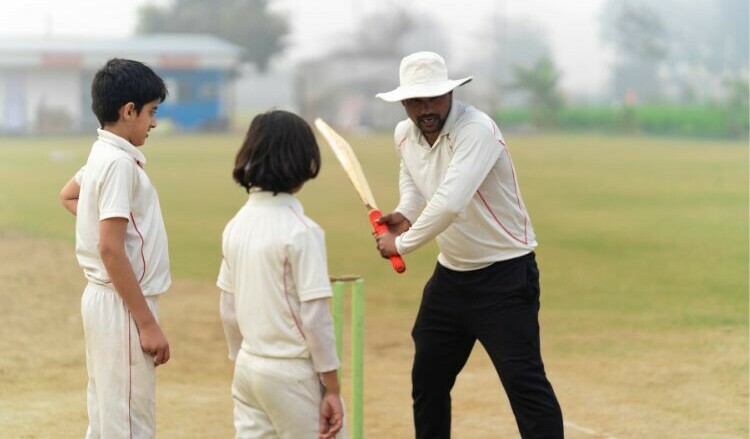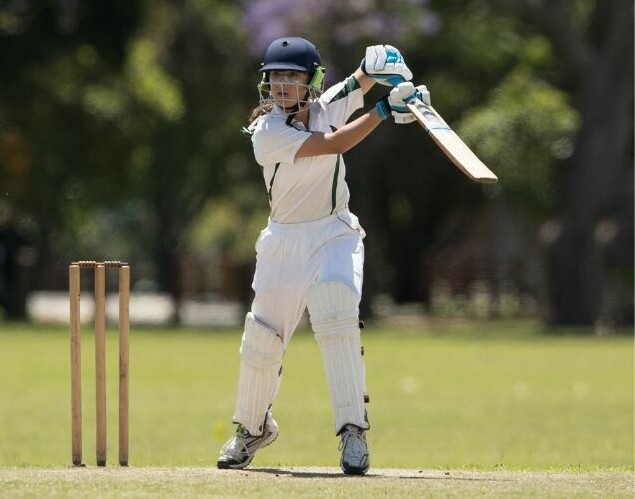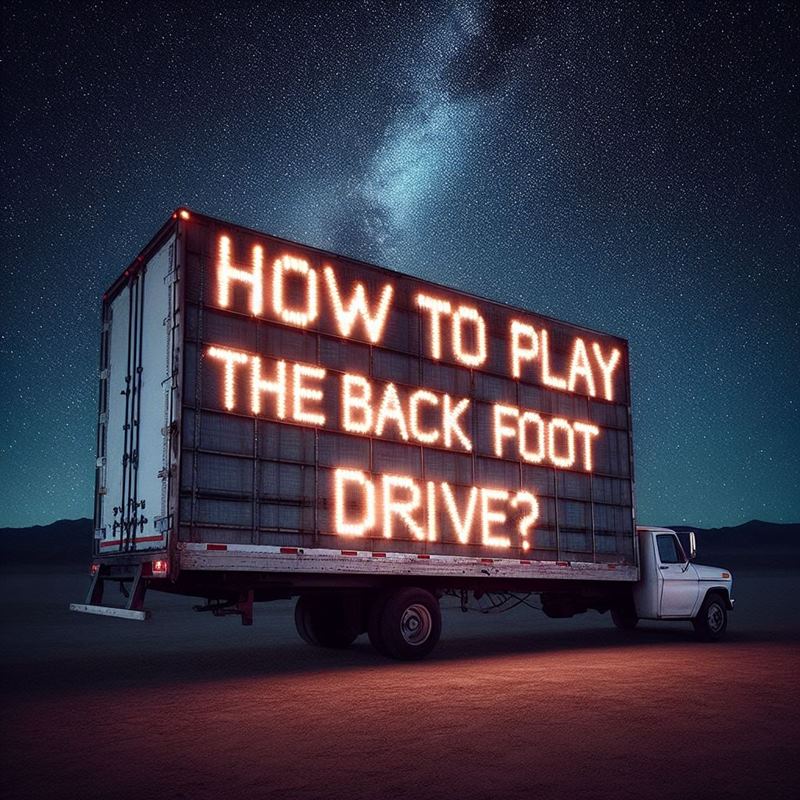Cricket offers an array of shots for players to master. Among these, the back foot drive stands out as a shot revered for its elegance and effectiveness.
At its core, the back foot drive is a batting shot where the batter leans onto their back foot to strike the ball. Similar to the back foot defence, the difference is that the back foot drive is an attacking shot, aimed at sending the ball through the in-field, hopefully to the boundary.
The back foot drive is very versatile and can be used across many different game situations. You can use it facing pace bowlers or spinners, on different types of pitches. If you can master the shot, it can be a game-changer for you; a potent weapon in your arsenal, which allows you to move from defence to attack with ease.
Early in your innings, when the ball is seaming or swinging, the back foot drive allows you, as the batter, to effectively negotiate any movement off the pitch or through the air. By staying back and playing the ball later, you minimize the risk of edging the ball to fielders from a ball that has moved slightly.
Moreover, against spinners, the back foot drive allows you to capitalize on length, punishing anything short with precise placement and timing.
Perfecting Your Technique: The Back Foot Drive Deconstructed
To master the back foot drive requires more than just raw power; it requires precision and finesse and technique. In the following few sections, we’ll provide you with a step-by-step guide on how to execute this shot.
Stance: The foundation to a successful back foot drive is the stance. You need to have a balanced and stable stance as that is essential to facilitate smooth weight transfer and movement to the back foot. Stay side on, keep your feet approximately shoulder-width apart, with your weight evenly distributed between both feet.
Footwork: When a bowler releases the ball, you must be able to judge the length and width of the position of the ball very quickly. Going back to a full ball can easily get you out leg before wicket or nicking to the slips. Going forward to a shorter ball can easily get you into a bad position, trying to play a ball that you should duck, or edging a ball off the shoulder of the bat.
If you judge the length to be a little short, your first movement should be moving your back leg towards the off stump. Not all the way to the stumps, of course, you don’t want to step on your stumps; but far enough back to allow you to get into a good position.
So that’s a step back and slightly towards off stump, to allow you to get closer to the line of the ball. Then, adjust your front foot accordingly. Your front foot should come back near to the back foot, to allow you a firm balance and a strong platform through which you will gain the power of your shot.
Body Balance: During all this time, you must maintain your balance. If, during practice, you feel unsteady on your feet during this step, perhaps worried about where your off-stump is, or uncomfortable with the movement in any way, try and try again. Muscle memory will soon take over and you will feel comfortable with the movement.
Bat swing: The back foot drive is a straight bat shot. What this means is that, as much as possible, the bat should be vertical at the time it hits the ball. This shows the full face of the ball towards the bat, and is less risky than a cross-bat shot (although, they have their uses, as we’ll see in later posts.)
Your head should be over the ball when you make contact, and your front elbow (left, if you’re right handed, and right, if you’re left handed) should be high. This allows you to get your bat on top of the bounce of the ball, so that the ball will head towards the ground rather than in the hands of a fielder for a catch.
Your upper hand is in control of the direction of the strike, and your lower hand gives the stroke its power.
With great timing, you will find you don’t need much of a follow-through of the bat after the ball is struck. A front foot drive is sometimes called a front foot punch, when the follow through the bat virtually stops at the impact of the ball. These types of shots can still race to the boundary if hit in the middle of the ball with great timing.
The Art of Timing: Enhancing Your Back Foot Drive

Speaking of ‘great timing’, timing is the essence of cricket. It holds particular significance when trying to master the back foot drive. Unlike some other drives where brute force can compensate for mistimed strokes, the back foot drive demands precision timing to connect the bat with the ball at the right moment in the bat’s sweet spot.
To perfect timing takes time, though. It takes practice. When you are in the nets, focus on developing a keen sense of judgement for the length and trajectory of each ball that comes your way. Spend time practicing against different types of bowlers and deliveries to refine your ability to read the length and line of the ball, as well as being able to pick up whether the ball is swinging, or seaming off the pitch.
Picking up the line of the ball quickly is key for every shot, especially the back foot drive. Every fraction of a second you can gain from a speedy (and correct, of course) judgement of the line and direction of the ball, you can use to get yourself in position to combat the ball.
Incorporate drills specifically designed to hone your timing skills. One effective drill is the throwdown drill, where a coach or teammate delivers balls to you at varying lengths and speeds. Concentrate on watching the ball closely and timing your strokes accordingly.
Eventually, it will become muscle memory.
Another useful drill is the shadow batting drill. This is where you simulate match scenarios by practicing your footwork and shot execution without a ball. Additionally, you can use video analysis to review your batting technique and timing. Identify those areas of improvement and work at them in the nets.
The Strategist’s Choice: Mastering Shot Selection

Shot selection is as much about strategy as it is about skill. So, when should you play defensively, and when should you unleash a little of your aggression on an attacking stroke?
The back foot drive is particularly aggressive against deliveries that are a little short of a good length. Additionally, when you are facing bowlers that are generating a bit more bounce than usual, or there is seam movement off the pitch, the back foot drives allows you a little more time to play the ball and adjust your shot for any variances off the pitch.
There are times when defence is warranted. When your team is under pressure or when the pitch conditions are challenging; in such circumstances, focusing on surviving the ball, or playing with soft hands and placing the ball into gaps rather than hitting the boundaries would be prudent.
However, there are other times when you need to seize the initiative. Aggressive back foot drives can tilt the momentum in your team’s favour. When the bowling is short or the bowler is offering a little width, you should capitalize on those slight errors; a powerful back foot drive in those circumstances can put pressure on the fielding side and dictate the tempo of the game.
Identifying common errors players make when attempting the back foot drive
Failing to watch the ball: You need to watch the ball until it hits the bat, otherwise you don’t have complete control of the shot and that leads to mistimed shots, edges to the keeper or slip cauldron or simple catches to the fielders in front of the bat.
Playing the ball too far from your body: The more the bat is away from the line of your eyes, the more difficult it is to control the shot. If you can’t see what you are doing, how can you know where the ball is going to go after it hits the bat? Keep the bat and your eyes as aligned as possible. Stay in line with the ball.
Playing the ball too high on the bat: Another way of saying this is that you need to get on top of the bounce of the ball. You want to hit the ball on the bat’s sweet spot. It’s where the most power is; it is also the middle of the bat, which is the furthest from the edges, and it is also usually about 5 or 6 to 12 inches from the toe of the bat.
To get the ball to hit the bat in the sweet spot on a ball that is bouncing from just short of a length, as will often be the case for a back foot drive, you need to get the bat up high, your hands well above the bounce of the ball. This requires high elbows and hands up near eye-level.
Any lower, and the ball will hit high on the bat, and you will have less control of where it then goes.
Last Words on the Back Foot Drive
The back foot drive isn’t just a stroke – it’s a reflection of your understanding of the game’s rhythm, your ability to read the situation and your skill in adjusting to different pitch conditions and bowlers’ strategies.
First, remember to get your stance correct. Stay balanced, and move your back foot back and to the off side, in line with the ball. With your front elbow high, hands above the bounce of the ball, bring the bat down and connect bat and ball at the sweet spot.
Keep practicing. It takes time to perform any shot well. Engage in regular drills that focus on both technique and mental fortitude.
And lastly, learn to adapt. The best cricketers don’t follow the coaching books to the letter. They start there, and tinker with the shot, finding what works best for them.
I hope you have enjoyed this post. If you have any stories about a back foot drive you’ve seen done to perfection, or if you can recall your own perfectly timed back foot drive, leave it in the comments below.
And come back again to read the next post in this series, How to Play the Cover Drive.

